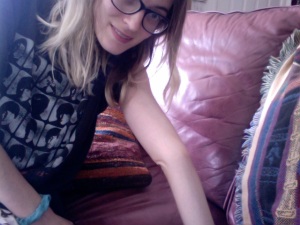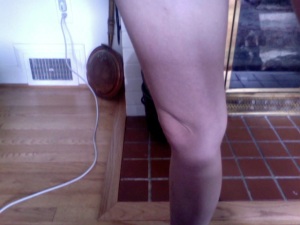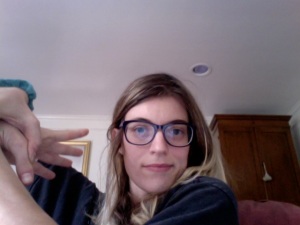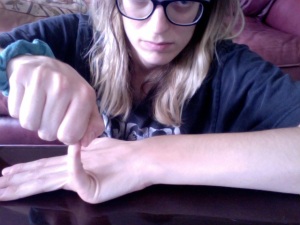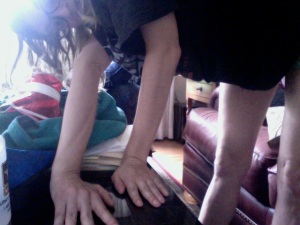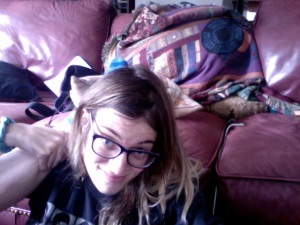So I want to give everyone who is reading a chance to see why I think I have Ehlers-Danlos Syndrome (EDS) in a visual, easy-to-see format. After all, one way a doctor diagnoses Ehlers-Danlos is by looking at the patient’s body.
First off, here I am:
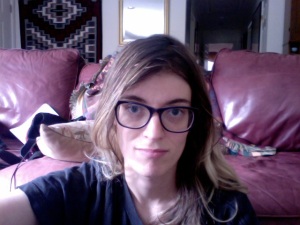
Image: Me, Beth, a 26-year-old thin, pale, white woman with blondish-brownish hair (with dark brown roots), purple glasses, dark eyebrows, dark blue eyes, and a black Beatles t-shirt. In the background is my parents’ living room (a leather sofa and a Navajo rug are seen).
According to the Ehlers-Danlos National Foundation (EDNF)’s site, the nosology (which is long and complicated; read the whole thing if you want more information) lists several different symptoms that are physical manifestations in the body.
Under the nosology’s “A) General Comments” section:
“1. Skin hyperextensibility should be tested at a neutral site, meaning a site not subjected to mechanical forces or scarring, e.g., the volar surface of the forearm. It is measured by pulling up the skin until resistance is felt. In young children, it is difficult to assess because of the abundance of subcutaneous fat [Beighton, 1993; Steinmann et al., 1993].”
Here are several photos of me showing off my stretchy skin:
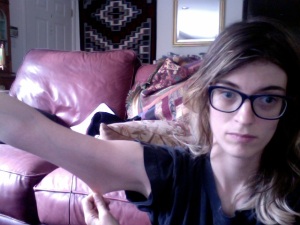
Image: Me, Beth, a 26-year-old thin, pale, white woman with blond-brown hair, purple glasses, blue eyes, and a black Beatles shirt. I am stretching the skin on my right upper arm (on the lower/tricep part).

Image: Me, Beth, a 26-year-old thin, pale, white woman, stretching the skin out on my lower right arm.

Image: Me, Beth, a 26-year-old thin, pale, white woman, stretching the skin out on my lower right arm (on the side facing palm down).
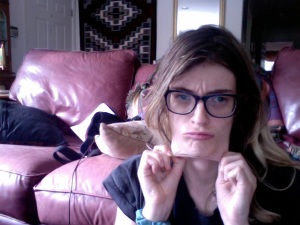
Image: This might be my favorite picture of me in this series. Look; my face is a square! XD Me, Beth, Image: Me, Beth, a 26-year-old thin, pale, white woman, stretching the skin on my face out so that my lower/chin skin makes my whole face look like a square.
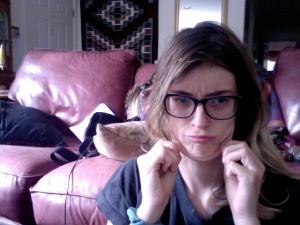
Image: Have you ever seen a thin person with a double chin? Now you have! Me, Beth, a 26-year-old thin, pale, white woman, stretching the skin on my face out so that my lower/chin skin looks like a double chin.
“2. Joint hypermobility should be assessed using the Beighton scale [Beighton et al., 1983]. Joint hypermobility depends on age, gender, family, and ethnic background. A score of 5/9 or greater defines hypermobility. The total score is obtained by:
a) passive dorsiflexion of the little fingers beyond 90 degrees; one point for each hand.
b) passive apposition of the thumbs to the flexor aspect of the forearm; one point for each hand.
c) hyperextension of the elbows beyond 10 degrees; one point for each elbow.
d) hyperextension of the knees beyond 10 degrees; one point for each knee.
e) forward flexion of the trunk with knees fully extended so that the palms of the hand rest flat on the floor; one point.”
Here is a visual illustration of the Beighton scale (thanks again to EDNF; this time, the image was found on EDNF’s page about assessing joint hypermobility):
!["The Beighton scale ... [Beighton et al., 1983]... Forward flexion of the trunk with knees fully extended so that the palms of the hand rest flat* on the floor – one point Hyperextension of the elbows beyond 10 degrees* – one point for each elbow Hyperextension of the knees beyond 10 degrees* – one point for each knee Passive apposition of the thumbs to the flexor aspect of the forearm* – one point for each hand Passive dorsiflexion of the little fingers beyond 90 degrees* – one point for each hand *Note: Picture may indicate a degree of hypermobility not required by the diagnostic criteria."](https://chronicillin.wordpress.com/wp-content/uploads/2014/07/beightonscaleforjointhypermobility.png?w=300&h=253)
“The Beighton scale … [Beighton et al., 1983]… Forward flexion of the trunk with knees fully extended so that the palms of the hand rest flat* on the floor – one point Hyperextension of the elbows beyond 10 degrees* – one point for each elbow Hyperextension of the knees beyond 10 degrees* – one point for each knee Passive apposition of the thumbs to the flexor aspect of the forearm* – one point for each hand Passive dorsiflexion of the little fingers beyond 90 degrees* – one point for each hand *Note: Picture may indicate a degree of hypermobility not required by the diagnostic criteria.”

Image: The closest I (Beth) can get to the criteria of putting my palms on the floor with my legs extended straight. I can only touch my toes for a second or two (it hurts my back and legs too much).
However, I can pretty much do the rest of the criteria under 2. (the Beighton scale).
My elbows and knees seem to bend back, although I don’t know if they bend back as far as 10 degrees or not; that would have to be measured.
“Passive apposition of the thumbs to the flexor aspect of the forearm* – one point for each hand”
I can definitely do these (and my cousin, Emma, can, too).
“Passive dorsiflexion of the little fingers beyond 90 degrees* – one point for each hand”
I can’t do it beyond ninety degrees, really, but I can do it to approximately a right angle with both pinky fingers.
I suppose I’d score something like an 8 out of 9 on the Beighton scale, if I’m not mistaken. I’d definitely get the 5/9 minimum score for hyperflexibility, anyway, I believe.
Unfortunately, I don’t have any pictures (that I know of, anyway; I’ll have to comb through the archives of my computer to really check) of any bruises that I’ve had, even though I do easily bruise, and frequently (which is a symptom, hence my mentioning it). I also have smooth, velvety skin, although I don’t know if there is really a way to capture this in a single photo. I also didn’t take any pictures of the few scars I have because I don’t know if they’re abnormal/EDS-like. And while I definitely have striae (stretch-marks), I’m not having much luck capturing them on my webcam (I miss my digital camera).
I don’t think I have the vascular type of EDS (we’ll find out eventually, I hope), but I do seem to have thin, translucent skin, which is listed under the major criteria of vascular EDS in the nosology. You can see my veins a lot of the time, and the veins are even more obvious when I’m a bit dehydrated and it’s hot outside or if I’ve just taken a shower (then they bulge out a bit sometimes, too, along with becoming a more pronounced blue).
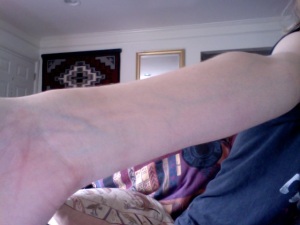
Image: Me, Beth, stretching out my right arm to demonstrate how thin and translucent my skin is and how the veins are visible through my skin.
As for EDS-related news, I haven’t heard anything further from Dr. Francomano’s office (nor was I suspecting to). So I decided to call Dr. Hal Dietz’s office (Dr. Hal Dietz is another connective tissues disorders specialist, but he specializes in Marfan syndrome, Loey-Dietz syndrome, and vascular EDS). It’s the McKusick-Nathans Institute of Genetic Medicine (at Johns Hopkins Hospital), and I think their office also has Dr. Howard Levy, another Ehlers-Danlos specialist.
Anyway, so I called the McKusick-Nathans Institute of Genetic Medicine, and they talked to me and e-mailed me a packet/questionnaire to fill out, which I have done for the most part (I think I just need to add a couple things). Their questionnaire is a lot shorter than the one Dr. Francomano’s office has, haha.
As for IBS/SIBO-related news, I had my first colonoscopy and endoscopy ever (at the ripe old age of twenty-six!) on July 24. They weren’t as bad as I thought they’d be, but I kinda want to write a separate entry here about them in detail (I’ll try not to include too much gross detail, though, hahaha).
After being more open about all my disorders and conditions, people have been really supportive and it’s been kind of reassuring, especially when it comes to EDS support as EDS is so rare (or at least so underdiagnosed that most people haven’t heard of it).
Because of all my disabilities (read my first blog entry if you don’t already know what they are) and because Maryland DORS, the state agency to help people with disabilities gain employment, is being glacially slow in helping me finding a job, my mother hired a friend of hers recently to help me out.
This friend of my mother’s (let’s call her D) has prior experience in human resources, and she’s trying to help me find employment with my disabilities. D encouraged me to apply to the National Telecommunicating Institute for a job. She also scheduled a conference call with my parents, my DORS counselor, and me. The day after I had a telephone interview with NTI, they sent me an automatic e-mail rejecting me. The day after that was supposed to be the conference call; when we had the conference call, D and I talked about what to do now that NRI had rejected me. My DORS counselor never came in on the call, and everyone (D, my parents, and I) was really disappointed.
My parents and D helped me write an e-mail to my DORS counselor explaining my frustration and trying to get a solid timeline on DORS’ services for me out of her. If that e-mail isn’t answered satisfactorily, my parents want to write to our senator (whom we like; he used to live in our neighborhood), Jim Brochin.
And switching back to the lighter topic of things my body does thanks to EDS, here are some other fun things I can do that you sometimes see other people with EDS doing on other sites:
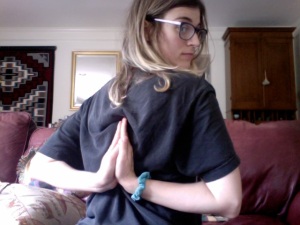
Image: Me, Beth, doing “reverse Namaskar” (folding my arms behind my back and touching my palms together like I’m praying).

Image: Me, Beth, displaying my fingers on both hands put them in the swan neck deformity position. The swan neck deformity is, according to Wikipedia, “a deformed position of the finger, in which the joint closest to the fingertip is permanently bent toward the palm while the nearest joint to the palm is bent away from it (DIP hyperflexion with PIP hyperextension).”
My fingers aren’t bent in the swan neck deformity all the time (unlike for some with rheumatoid arthritis who have that as their default finger position), but I can do it.
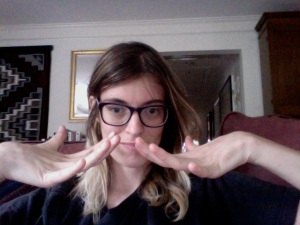
Image: Me, Beth, displaying the flying bird sign with both of my hands (hand curves so that the tips of the fingers and the wrist go up in separate directions and the top of the palm of the hand points toward the ground).
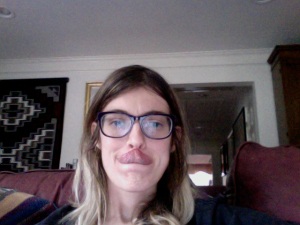
Image: Me, Beth, touching my tongue to the tip of my nose (which is part of the Gorlin sign, the ability to touch tip of nose with tongue and ability to touch the elbow with tongue).

Image: Me, Beth, touching my tongue almost to my elbow (which is part of the Gorlin sign, the ability to touch tip of nose with tongue and ability to touch the elbow with tongue).
I don’t know how reliable the Wikipedia page on the Gorlin sign is, but according to said page, “[a]pproximately ten percent of the general population can perform this act, whereas five times as many people with Ehlers[-]Danlos can.”
And, of course, I can do everyone’s favorite circus trick:
I can actually put both feet behind my head at the same time, but honestly, I didn’t feel like it today. I was already tired from showing my friend Christa last night that I could do it (and I also showed her my impromptu, made-up-on-the-spot breakdancing skills, hahaha).
I will post more photographs illustrating how EDS makes my body different or special as the occasions arise and an entry later about my colonoscopy and endoscopy procedure, but for now, I’m going to wrap up this entry and have dinner.
I hope this blog entry gave some of you who aren’t familiar with Ehlers-Danlos Syndrome some insight into the condition and what it looks like.

